The Effects of Social Media on Health and Social Care: A Report
VerifiedAdded on 2022/08/26
|15
|4008
|14
Report
AI Summary
This report delves into the significant impact of social media platforms, particularly Instagram, on the mental health and well-being of young people. It examines the increased prevalence of mental health issues, such as anxiety and depression, among adolescents and the potential contributing factors related to social media use. The report reviews existing literature on topics including the vulnerability of women, the influence of Instagram on mental health, social networking's effect on self-esteem and depression, and the correlation between social media use and conditions like orthorexia nervosa. It analyzes data from various studies and reports, including the Royal Society for Public Health and the NHS, to understand the negative effects of social media on body image, cyberbullying, and the fear of missing out. The report also touches upon the role of media in shaping perceptions of mental illness and the need for strategies to mitigate these effects, providing a comprehensive overview of the complex relationship between social media and the mental health of young people in the UK and beyond.
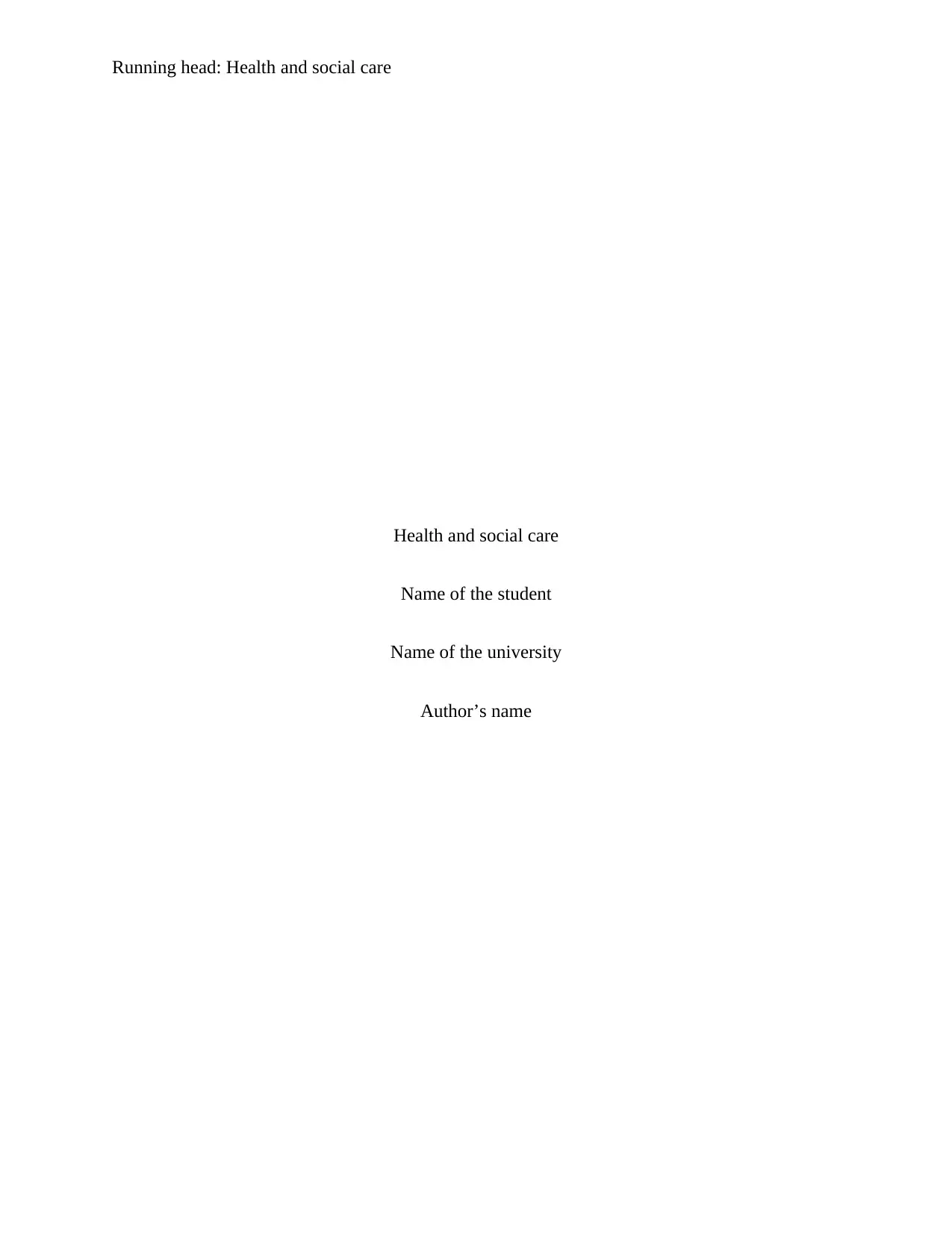
Running head: Health and social care
Health and social care
Name of the student
Name of the university
Author’s name
Health and social care
Name of the student
Name of the university
Author’s name
Paraphrase This Document
Need a fresh take? Get an instant paraphrase of this document with our AI Paraphraser
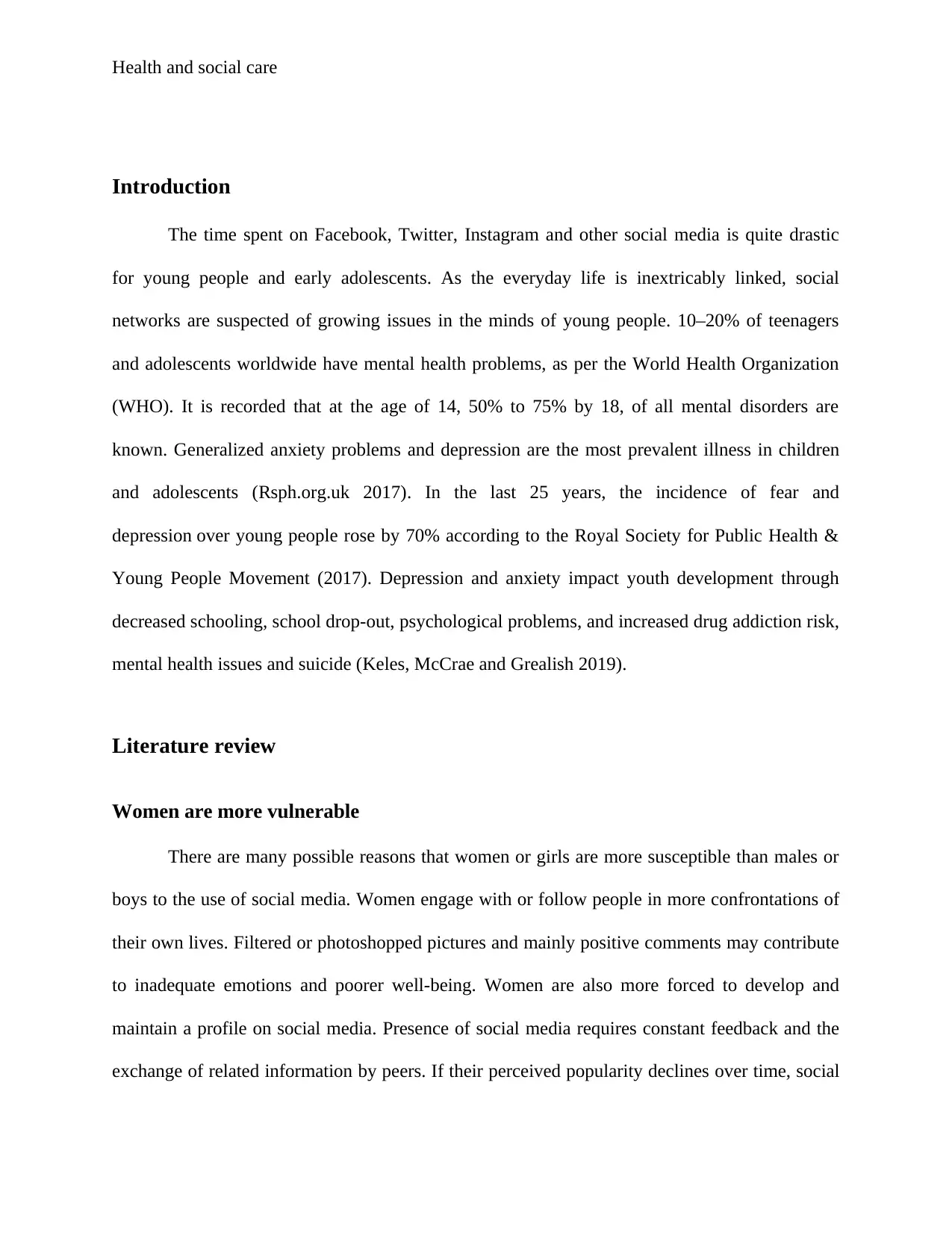
Health and social care
Introduction
The time spent on Facebook, Twitter, Instagram and other social media is quite drastic
for young people and early adolescents. As the everyday life is inextricably linked, social
networks are suspected of growing issues in the minds of young people. 10–20% of teenagers
and adolescents worldwide have mental health problems, as per the World Health Organization
(WHO). It is recorded that at the age of 14, 50% to 75% by 18, of all mental disorders are
known. Generalized anxiety problems and depression are the most prevalent illness in children
and adolescents (Rsph.org.uk 2017). In the last 25 years, the incidence of fear and
depression over young people rose by 70% according to the Royal Society for Public Health &
Young People Movement (2017). Depression and anxiety impact youth development through
decreased schooling, school drop-out, psychological problems, and increased drug addiction risk,
mental health issues and suicide (Keles, McCrae and Grealish 2019).
Literature review
Women are more vulnerable
There are many possible reasons that women or girls are more susceptible than males or
boys to the use of social media. Women engage with or follow people in more confrontations of
their own lives. Filtered or photoshopped pictures and mainly positive comments may contribute
to inadequate emotions and poorer well-being. Women are also more forced to develop and
maintain a profile on social media. Presence of social media requires constant feedback and the
exchange of related information by peers. If their perceived popularity declines over time, social
Introduction
The time spent on Facebook, Twitter, Instagram and other social media is quite drastic
for young people and early adolescents. As the everyday life is inextricably linked, social
networks are suspected of growing issues in the minds of young people. 10–20% of teenagers
and adolescents worldwide have mental health problems, as per the World Health Organization
(WHO). It is recorded that at the age of 14, 50% to 75% by 18, of all mental disorders are
known. Generalized anxiety problems and depression are the most prevalent illness in children
and adolescents (Rsph.org.uk 2017). In the last 25 years, the incidence of fear and
depression over young people rose by 70% according to the Royal Society for Public Health &
Young People Movement (2017). Depression and anxiety impact youth development through
decreased schooling, school drop-out, psychological problems, and increased drug addiction risk,
mental health issues and suicide (Keles, McCrae and Grealish 2019).
Literature review
Women are more vulnerable
There are many possible reasons that women or girls are more susceptible than males or
boys to the use of social media. Women engage with or follow people in more confrontations of
their own lives. Filtered or photoshopped pictures and mainly positive comments may contribute
to inadequate emotions and poorer well-being. Women are also more forced to develop and
maintain a profile on social media. Presence of social media requires constant feedback and the
exchange of related information by peers. If their perceived popularity declines over time, social
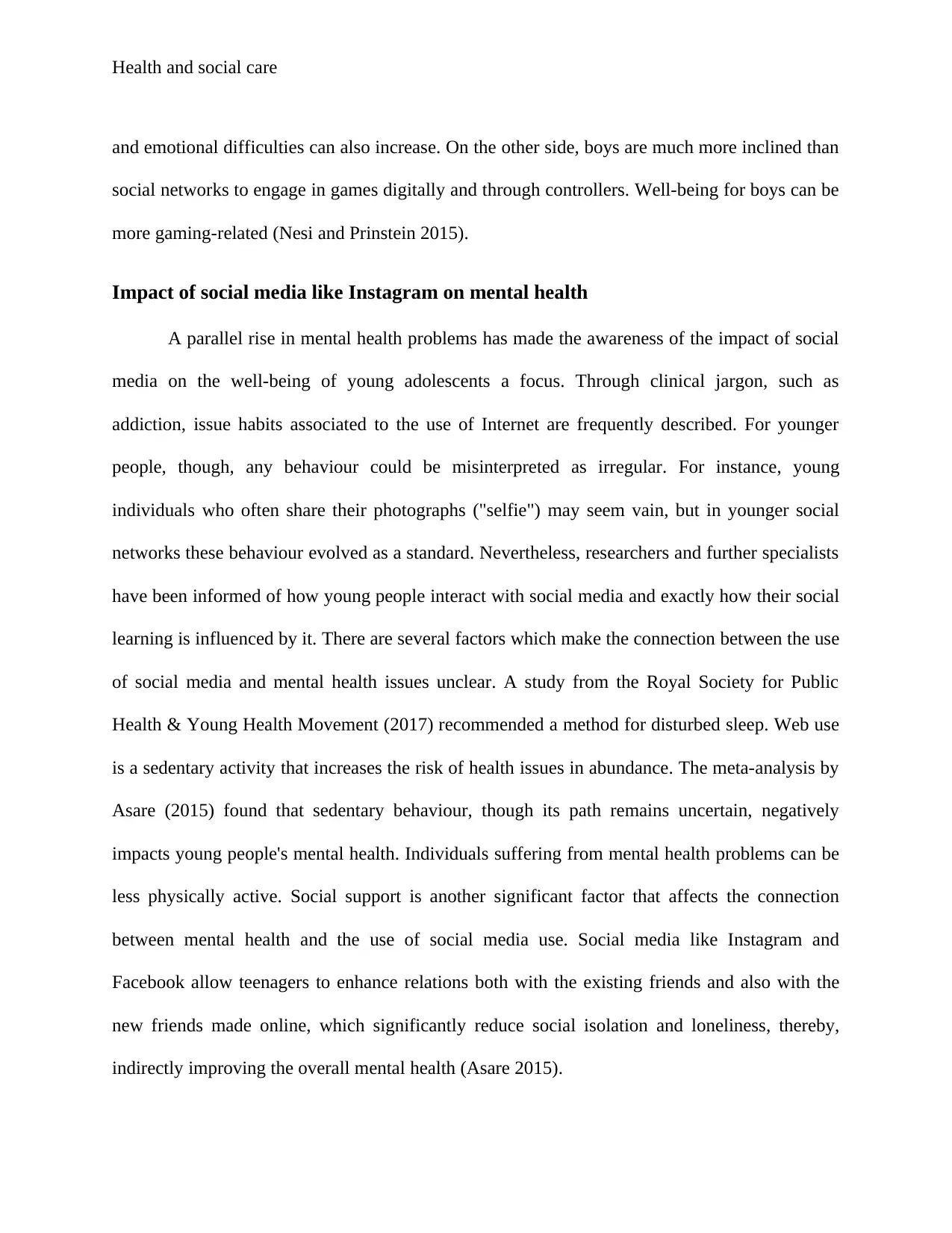
Health and social care
and emotional difficulties can also increase. On the other side, boys are much more inclined than
social networks to engage in games digitally and through controllers. Well-being for boys can be
more gaming-related (Nesi and Prinstein 2015).
Impact of social media like Instagram on mental health
A parallel rise in mental health problems has made the awareness of the impact of social
media on the well-being of young adolescents a focus. Through clinical jargon, such as
addiction, issue habits associated to the use of Internet are frequently described. For younger
people, though, any behaviour could be misinterpreted as irregular. For instance, young
individuals who often share their photographs ("selfie") may seem vain, but in younger social
networks these behaviour evolved as a standard. Nevertheless, researchers and further specialists
have been informed of how young people interact with social media and exactly how their social
learning is influenced by it. There are several factors which make the connection between the use
of social media and mental health issues unclear. A study from the Royal Society for Public
Health & Young Health Movement (2017) recommended a method for disturbed sleep. Web use
is a sedentary activity that increases the risk of health issues in abundance. The meta-analysis by
Asare (2015) found that sedentary behaviour, though its path remains uncertain, negatively
impacts young people's mental health. Individuals suffering from mental health problems can be
less physically active. Social support is another significant factor that affects the connection
between mental health and the use of social media use. Social media like Instagram and
Facebook allow teenagers to enhance relations both with the existing friends and also with the
new friends made online, which significantly reduce social isolation and loneliness, thereby,
indirectly improving the overall mental health (Asare 2015).
and emotional difficulties can also increase. On the other side, boys are much more inclined than
social networks to engage in games digitally and through controllers. Well-being for boys can be
more gaming-related (Nesi and Prinstein 2015).
Impact of social media like Instagram on mental health
A parallel rise in mental health problems has made the awareness of the impact of social
media on the well-being of young adolescents a focus. Through clinical jargon, such as
addiction, issue habits associated to the use of Internet are frequently described. For younger
people, though, any behaviour could be misinterpreted as irregular. For instance, young
individuals who often share their photographs ("selfie") may seem vain, but in younger social
networks these behaviour evolved as a standard. Nevertheless, researchers and further specialists
have been informed of how young people interact with social media and exactly how their social
learning is influenced by it. There are several factors which make the connection between the use
of social media and mental health issues unclear. A study from the Royal Society for Public
Health & Young Health Movement (2017) recommended a method for disturbed sleep. Web use
is a sedentary activity that increases the risk of health issues in abundance. The meta-analysis by
Asare (2015) found that sedentary behaviour, though its path remains uncertain, negatively
impacts young people's mental health. Individuals suffering from mental health problems can be
less physically active. Social support is another significant factor that affects the connection
between mental health and the use of social media use. Social media like Instagram and
Facebook allow teenagers to enhance relations both with the existing friends and also with the
new friends made online, which significantly reduce social isolation and loneliness, thereby,
indirectly improving the overall mental health (Asare 2015).
⊘ This is a preview!⊘
Do you want full access?
Subscribe today to unlock all pages.

Trusted by 1+ million students worldwide
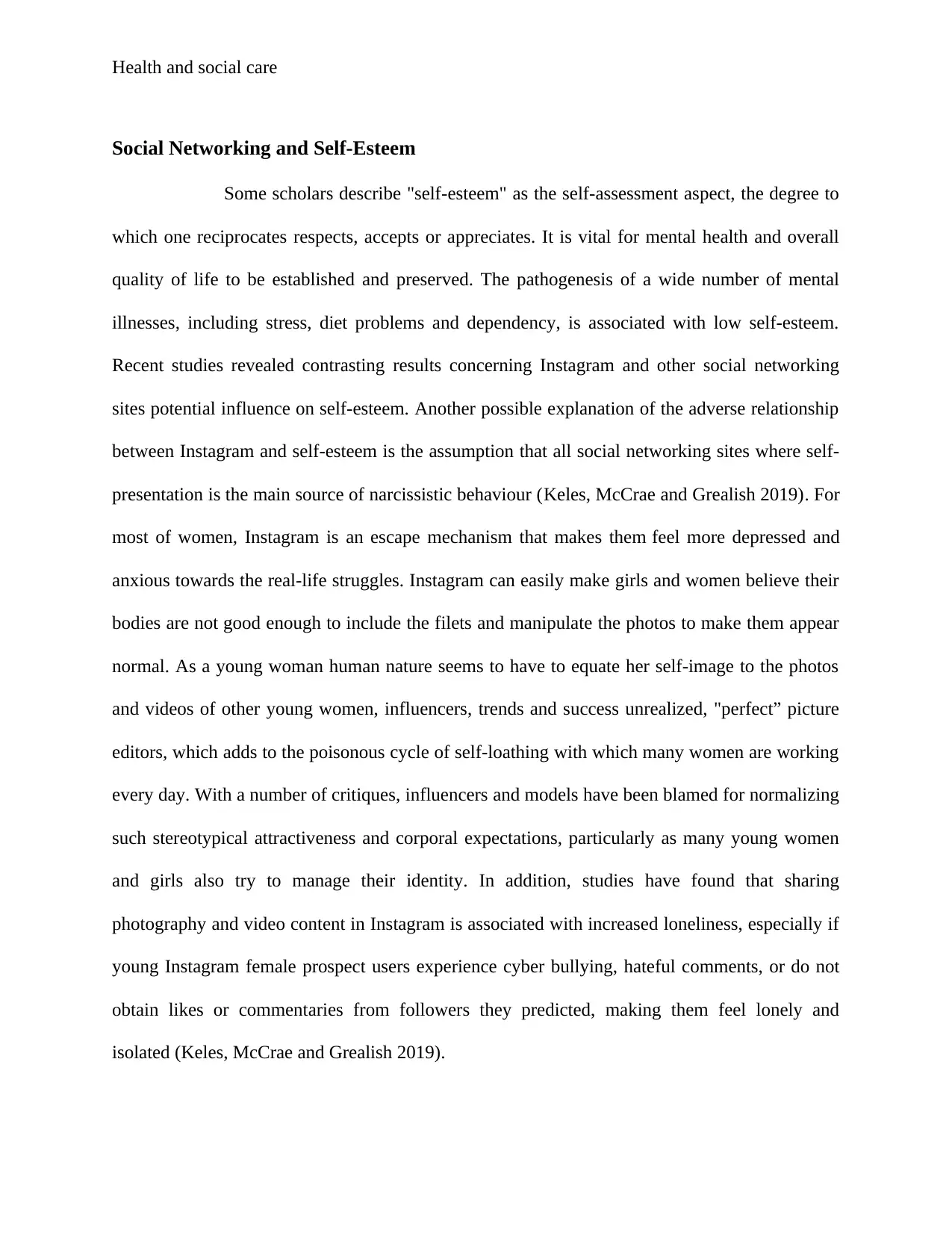
Health and social care
Social Networking and Self-Esteem
Some scholars describe "self-esteem" as the self-assessment aspect, the degree to
which one reciprocates respects, accepts or appreciates. It is vital for mental health and overall
quality of life to be established and preserved. The pathogenesis of a wide number of mental
illnesses, including stress, diet problems and dependency, is associated with low self-esteem.
Recent studies revealed contrasting results concerning Instagram and other social networking
sites potential influence on self-esteem. Another possible explanation of the adverse relationship
between Instagram and self-esteem is the assumption that all social networking sites where self-
presentation is the main source of narcissistic behaviour (Keles, McCrae and Grealish 2019). For
most of women, Instagram is an escape mechanism that makes them feel more depressed and
anxious towards the real-life struggles. Instagram can easily make girls and women believe their
bodies are not good enough to include the filets and manipulate the photos to make them appear
normal. As a young woman human nature seems to have to equate her self-image to the photos
and videos of other young women, influencers, trends and success unrealized, "perfect” picture
editors, which adds to the poisonous cycle of self-loathing with which many women are working
every day. With a number of critiques, influencers and models have been blamed for normalizing
such stereotypical attractiveness and corporal expectations, particularly as many young women
and girls also try to manage their identity. In addition, studies have found that sharing
photography and video content in Instagram is associated with increased loneliness, especially if
young Instagram female prospect users experience cyber bullying, hateful comments, or do not
obtain likes or commentaries from followers they predicted, making them feel lonely and
isolated (Keles, McCrae and Grealish 2019).
Social Networking and Self-Esteem
Some scholars describe "self-esteem" as the self-assessment aspect, the degree to
which one reciprocates respects, accepts or appreciates. It is vital for mental health and overall
quality of life to be established and preserved. The pathogenesis of a wide number of mental
illnesses, including stress, diet problems and dependency, is associated with low self-esteem.
Recent studies revealed contrasting results concerning Instagram and other social networking
sites potential influence on self-esteem. Another possible explanation of the adverse relationship
between Instagram and self-esteem is the assumption that all social networking sites where self-
presentation is the main source of narcissistic behaviour (Keles, McCrae and Grealish 2019). For
most of women, Instagram is an escape mechanism that makes them feel more depressed and
anxious towards the real-life struggles. Instagram can easily make girls and women believe their
bodies are not good enough to include the filets and manipulate the photos to make them appear
normal. As a young woman human nature seems to have to equate her self-image to the photos
and videos of other young women, influencers, trends and success unrealized, "perfect” picture
editors, which adds to the poisonous cycle of self-loathing with which many women are working
every day. With a number of critiques, influencers and models have been blamed for normalizing
such stereotypical attractiveness and corporal expectations, particularly as many young women
and girls also try to manage their identity. In addition, studies have found that sharing
photography and video content in Instagram is associated with increased loneliness, especially if
young Instagram female prospect users experience cyber bullying, hateful comments, or do not
obtain likes or commentaries from followers they predicted, making them feel lonely and
isolated (Keles, McCrae and Grealish 2019).
Paraphrase This Document
Need a fresh take? Get an instant paraphrase of this document with our AI Paraphraser
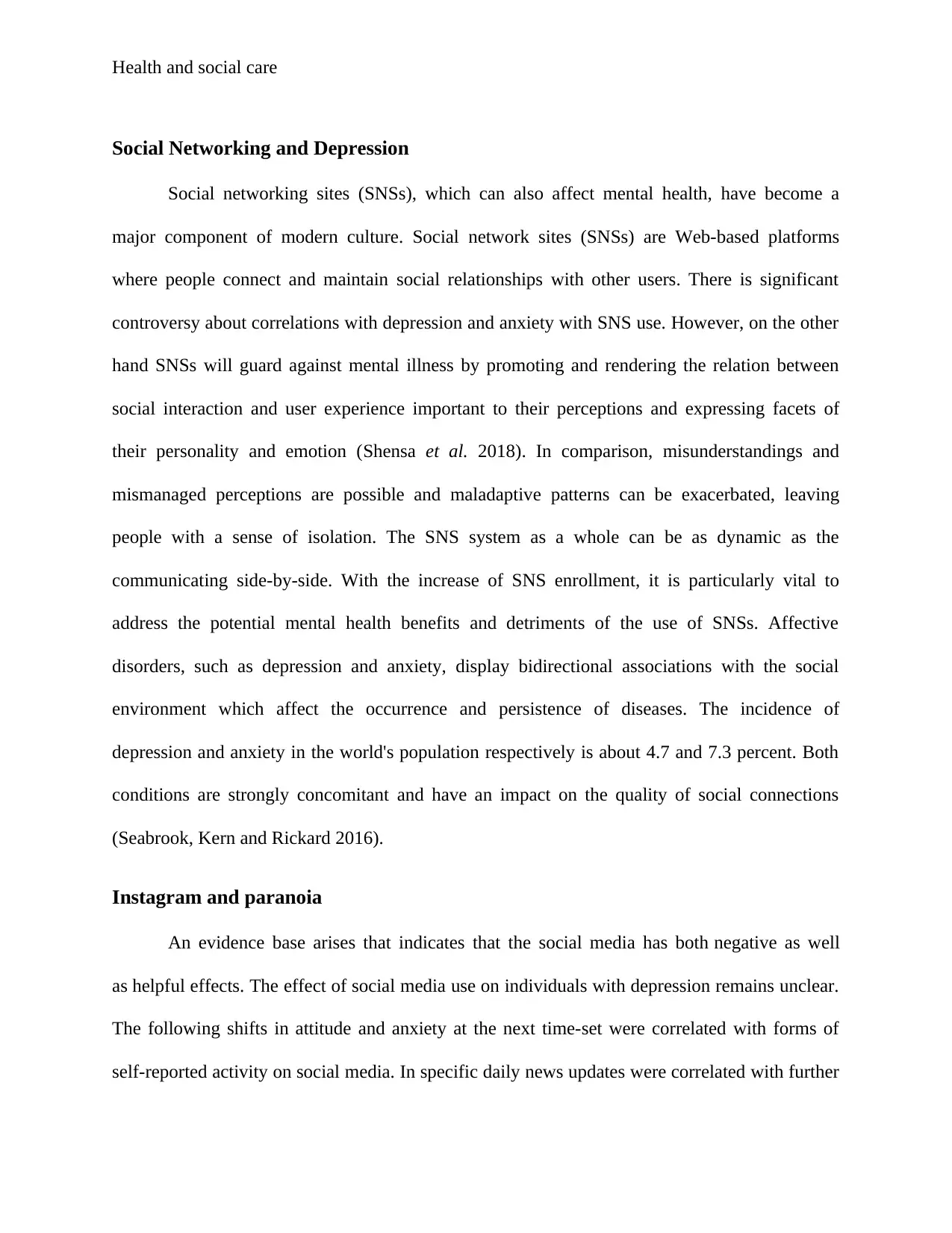
Health and social care
Social Networking and Depression
Social networking sites (SNSs), which can also affect mental health, have become a
major component of modern culture. Social network sites (SNSs) are Web-based platforms
where people connect and maintain social relationships with other users. There is significant
controversy about correlations with depression and anxiety with SNS use. However, on the other
hand SNSs will guard against mental illness by promoting and rendering the relation between
social interaction and user experience important to their perceptions and expressing facets of
their personality and emotion (Shensa et al. 2018). In comparison, misunderstandings and
mismanaged perceptions are possible and maladaptive patterns can be exacerbated, leaving
people with a sense of isolation. The SNS system as a whole can be as dynamic as the
communicating side-by-side. With the increase of SNS enrollment, it is particularly vital to
address the potential mental health benefits and detriments of the use of SNSs. Affective
disorders, such as depression and anxiety, display bidirectional associations with the social
environment which affect the occurrence and persistence of diseases. The incidence of
depression and anxiety in the world's population respectively is about 4.7 and 7.3 percent. Both
conditions are strongly concomitant and have an impact on the quality of social connections
(Seabrook, Kern and Rickard 2016).
Instagram and paranoia
An evidence base arises that indicates that the social media has both negative as well
as helpful effects. The effect of social media use on individuals with depression remains unclear.
The following shifts in attitude and anxiety at the next time-set were correlated with forms of
self-reported activity on social media. In specific daily news updates were correlated with further
Social Networking and Depression
Social networking sites (SNSs), which can also affect mental health, have become a
major component of modern culture. Social network sites (SNSs) are Web-based platforms
where people connect and maintain social relationships with other users. There is significant
controversy about correlations with depression and anxiety with SNS use. However, on the other
hand SNSs will guard against mental illness by promoting and rendering the relation between
social interaction and user experience important to their perceptions and expressing facets of
their personality and emotion (Shensa et al. 2018). In comparison, misunderstandings and
mismanaged perceptions are possible and maladaptive patterns can be exacerbated, leaving
people with a sense of isolation. The SNS system as a whole can be as dynamic as the
communicating side-by-side. With the increase of SNS enrollment, it is particularly vital to
address the potential mental health benefits and detriments of the use of SNSs. Affective
disorders, such as depression and anxiety, display bidirectional associations with the social
environment which affect the occurrence and persistence of diseases. The incidence of
depression and anxiety in the world's population respectively is about 4.7 and 7.3 percent. Both
conditions are strongly concomitant and have an impact on the quality of social connections
(Seabrook, Kern and Rickard 2016).
Instagram and paranoia
An evidence base arises that indicates that the social media has both negative as well
as helpful effects. The effect of social media use on individuals with depression remains unclear.
The following shifts in attitude and anxiety at the next time-set were correlated with forms of
self-reported activity on social media. In specific daily news updates were correlated with further
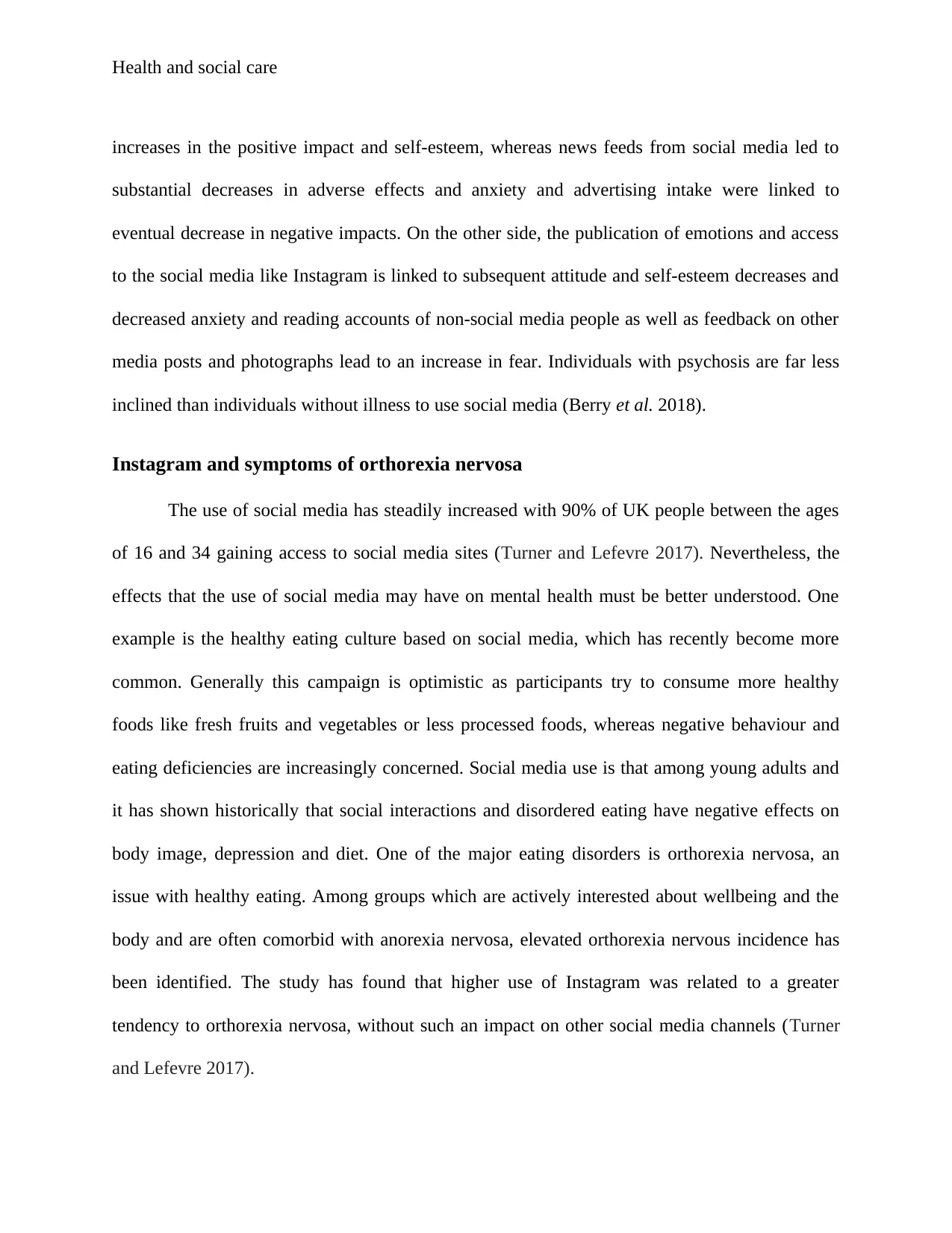
Health and social care
increases in the positive impact and self-esteem, whereas news feeds from social media led to
substantial decreases in adverse effects and anxiety and advertising intake were linked to
eventual decrease in negative impacts. On the other side, the publication of emotions and access
to the social media like Instagram is linked to subsequent attitude and self-esteem decreases and
decreased anxiety and reading accounts of non-social media people as well as feedback on other
media posts and photographs lead to an increase in fear. Individuals with psychosis are far less
inclined than individuals without illness to use social media (Berry et al. 2018).
Instagram and symptoms of orthorexia nervosa
The use of social media has steadily increased with 90% of UK people between the ages
of 16 and 34 gaining access to social media sites (Turner and Lefevre 2017). Nevertheless, the
effects that the use of social media may have on mental health must be better understood. One
example is the healthy eating culture based on social media, which has recently become more
common. Generally this campaign is optimistic as participants try to consume more healthy
foods like fresh fruits and vegetables or less processed foods, whereas negative behaviour and
eating deficiencies are increasingly concerned. Social media use is that among young adults and
it has shown historically that social interactions and disordered eating have negative effects on
body image, depression and diet. One of the major eating disorders is orthorexia nervosa, an
issue with healthy eating. Among groups which are actively interested about wellbeing and the
body and are often comorbid with anorexia nervosa, elevated orthorexia nervous incidence has
been identified. The study has found that higher use of Instagram was related to a greater
tendency to orthorexia nervosa, without such an impact on other social media channels (Turner
and Lefevre 2017).
increases in the positive impact and self-esteem, whereas news feeds from social media led to
substantial decreases in adverse effects and anxiety and advertising intake were linked to
eventual decrease in negative impacts. On the other side, the publication of emotions and access
to the social media like Instagram is linked to subsequent attitude and self-esteem decreases and
decreased anxiety and reading accounts of non-social media people as well as feedback on other
media posts and photographs lead to an increase in fear. Individuals with psychosis are far less
inclined than individuals without illness to use social media (Berry et al. 2018).
Instagram and symptoms of orthorexia nervosa
The use of social media has steadily increased with 90% of UK people between the ages
of 16 and 34 gaining access to social media sites (Turner and Lefevre 2017). Nevertheless, the
effects that the use of social media may have on mental health must be better understood. One
example is the healthy eating culture based on social media, which has recently become more
common. Generally this campaign is optimistic as participants try to consume more healthy
foods like fresh fruits and vegetables or less processed foods, whereas negative behaviour and
eating deficiencies are increasingly concerned. Social media use is that among young adults and
it has shown historically that social interactions and disordered eating have negative effects on
body image, depression and diet. One of the major eating disorders is orthorexia nervosa, an
issue with healthy eating. Among groups which are actively interested about wellbeing and the
body and are often comorbid with anorexia nervosa, elevated orthorexia nervous incidence has
been identified. The study has found that higher use of Instagram was related to a greater
tendency to orthorexia nervosa, without such an impact on other social media channels (Turner
and Lefevre 2017).
⊘ This is a preview!⊘
Do you want full access?
Subscribe today to unlock all pages.

Trusted by 1+ million students worldwide
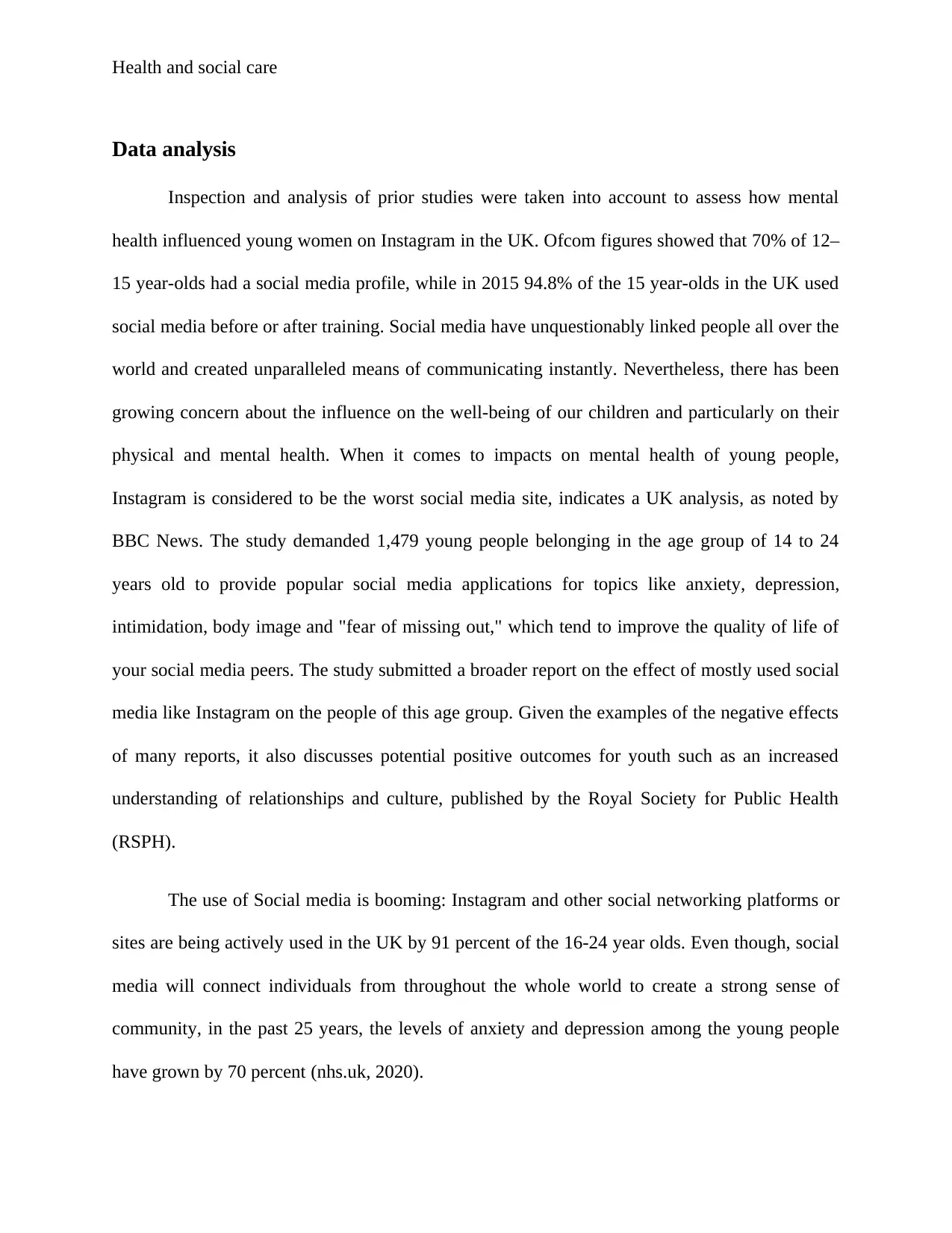
Health and social care
Data analysis
Inspection and analysis of prior studies were taken into account to assess how mental
health influenced young women on Instagram in the UK. Ofcom figures showed that 70% of 12–
15 year-olds had a social media profile, while in 2015 94.8% of the 15 year-olds in the UK used
social media before or after training. Social media have unquestionably linked people all over the
world and created unparalleled means of communicating instantly. Nevertheless, there has been
growing concern about the influence on the well-being of our children and particularly on their
physical and mental health. When it comes to impacts on mental health of young people,
Instagram is considered to be the worst social media site, indicates a UK analysis, as noted by
BBC News. The study demanded 1,479 young people belonging in the age group of 14 to 24
years old to provide popular social media applications for topics like anxiety, depression,
intimidation, body image and "fear of missing out," which tend to improve the quality of life of
your social media peers. The study submitted a broader report on the effect of mostly used social
media like Instagram on the people of this age group. Given the examples of the negative effects
of many reports, it also discusses potential positive outcomes for youth such as an increased
understanding of relationships and culture, published by the Royal Society for Public Health
(RSPH).
The use of Social media is booming: Instagram and other social networking platforms or
sites are being actively used in the UK by 91 percent of the 16-24 year olds. Even though, social
media will connect individuals from throughout the whole world to create a strong sense of
community, in the past 25 years, the levels of anxiety and depression among the young people
have grown by 70 percent (nhs.uk, 2020).
Data analysis
Inspection and analysis of prior studies were taken into account to assess how mental
health influenced young women on Instagram in the UK. Ofcom figures showed that 70% of 12–
15 year-olds had a social media profile, while in 2015 94.8% of the 15 year-olds in the UK used
social media before or after training. Social media have unquestionably linked people all over the
world and created unparalleled means of communicating instantly. Nevertheless, there has been
growing concern about the influence on the well-being of our children and particularly on their
physical and mental health. When it comes to impacts on mental health of young people,
Instagram is considered to be the worst social media site, indicates a UK analysis, as noted by
BBC News. The study demanded 1,479 young people belonging in the age group of 14 to 24
years old to provide popular social media applications for topics like anxiety, depression,
intimidation, body image and "fear of missing out," which tend to improve the quality of life of
your social media peers. The study submitted a broader report on the effect of mostly used social
media like Instagram on the people of this age group. Given the examples of the negative effects
of many reports, it also discusses potential positive outcomes for youth such as an increased
understanding of relationships and culture, published by the Royal Society for Public Health
(RSPH).
The use of Social media is booming: Instagram and other social networking platforms or
sites are being actively used in the UK by 91 percent of the 16-24 year olds. Even though, social
media will connect individuals from throughout the whole world to create a strong sense of
community, in the past 25 years, the levels of anxiety and depression among the young people
have grown by 70 percent (nhs.uk, 2020).
Paraphrase This Document
Need a fresh take? Get an instant paraphrase of this document with our AI Paraphraser
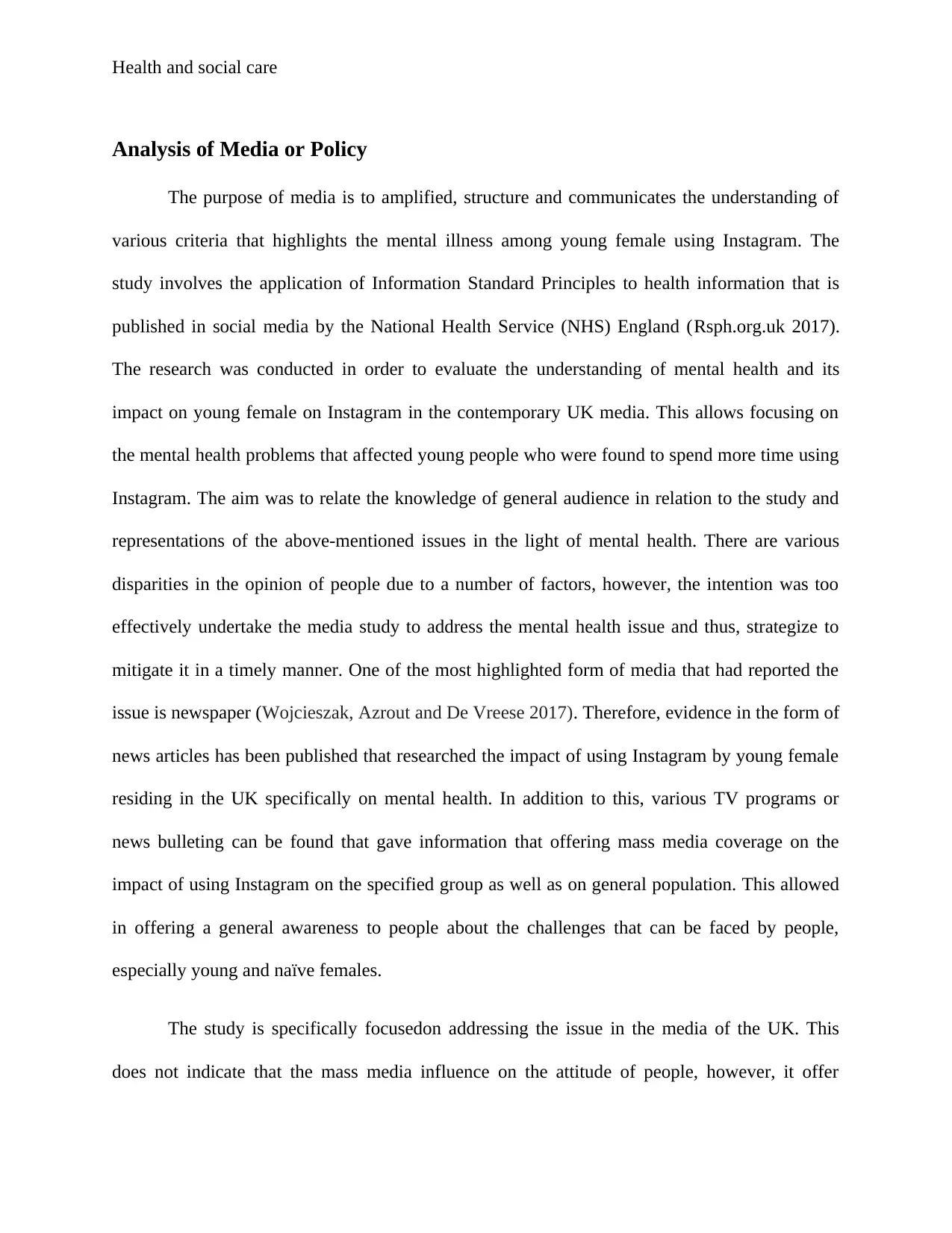
Health and social care
Analysis of Media or Policy
The purpose of media is to amplified, structure and communicates the understanding of
various criteria that highlights the mental illness among young female using Instagram. The
study involves the application of Information Standard Principles to health information that is
published in social media by the National Health Service (NHS) England (Rsph.org.uk 2017).
The research was conducted in order to evaluate the understanding of mental health and its
impact on young female on Instagram in the contemporary UK media. This allows focusing on
the mental health problems that affected young people who were found to spend more time using
Instagram. The aim was to relate the knowledge of general audience in relation to the study and
representations of the above-mentioned issues in the light of mental health. There are various
disparities in the opinion of people due to a number of factors, however, the intention was too
effectively undertake the media study to address the mental health issue and thus, strategize to
mitigate it in a timely manner. One of the most highlighted form of media that had reported the
issue is newspaper (Wojcieszak, Azrout and De Vreese 2017). Therefore, evidence in the form of
news articles has been published that researched the impact of using Instagram by young female
residing in the UK specifically on mental health. In addition to this, various TV programs or
news bulleting can be found that gave information that offering mass media coverage on the
impact of using Instagram on the specified group as well as on general population. This allowed
in offering a general awareness to people about the challenges that can be faced by people,
especially young and naïve females.
The study is specifically focusedon addressing the issue in the media of the UK. This
does not indicate that the mass media influence on the attitude of people, however, it offer
Analysis of Media or Policy
The purpose of media is to amplified, structure and communicates the understanding of
various criteria that highlights the mental illness among young female using Instagram. The
study involves the application of Information Standard Principles to health information that is
published in social media by the National Health Service (NHS) England (Rsph.org.uk 2017).
The research was conducted in order to evaluate the understanding of mental health and its
impact on young female on Instagram in the contemporary UK media. This allows focusing on
the mental health problems that affected young people who were found to spend more time using
Instagram. The aim was to relate the knowledge of general audience in relation to the study and
representations of the above-mentioned issues in the light of mental health. There are various
disparities in the opinion of people due to a number of factors, however, the intention was too
effectively undertake the media study to address the mental health issue and thus, strategize to
mitigate it in a timely manner. One of the most highlighted form of media that had reported the
issue is newspaper (Wojcieszak, Azrout and De Vreese 2017). Therefore, evidence in the form of
news articles has been published that researched the impact of using Instagram by young female
residing in the UK specifically on mental health. In addition to this, various TV programs or
news bulleting can be found that gave information that offering mass media coverage on the
impact of using Instagram on the specified group as well as on general population. This allowed
in offering a general awareness to people about the challenges that can be faced by people,
especially young and naïve females.
The study is specifically focusedon addressing the issue in the media of the UK. This
does not indicate that the mass media influence on the attitude of people, however, it offer
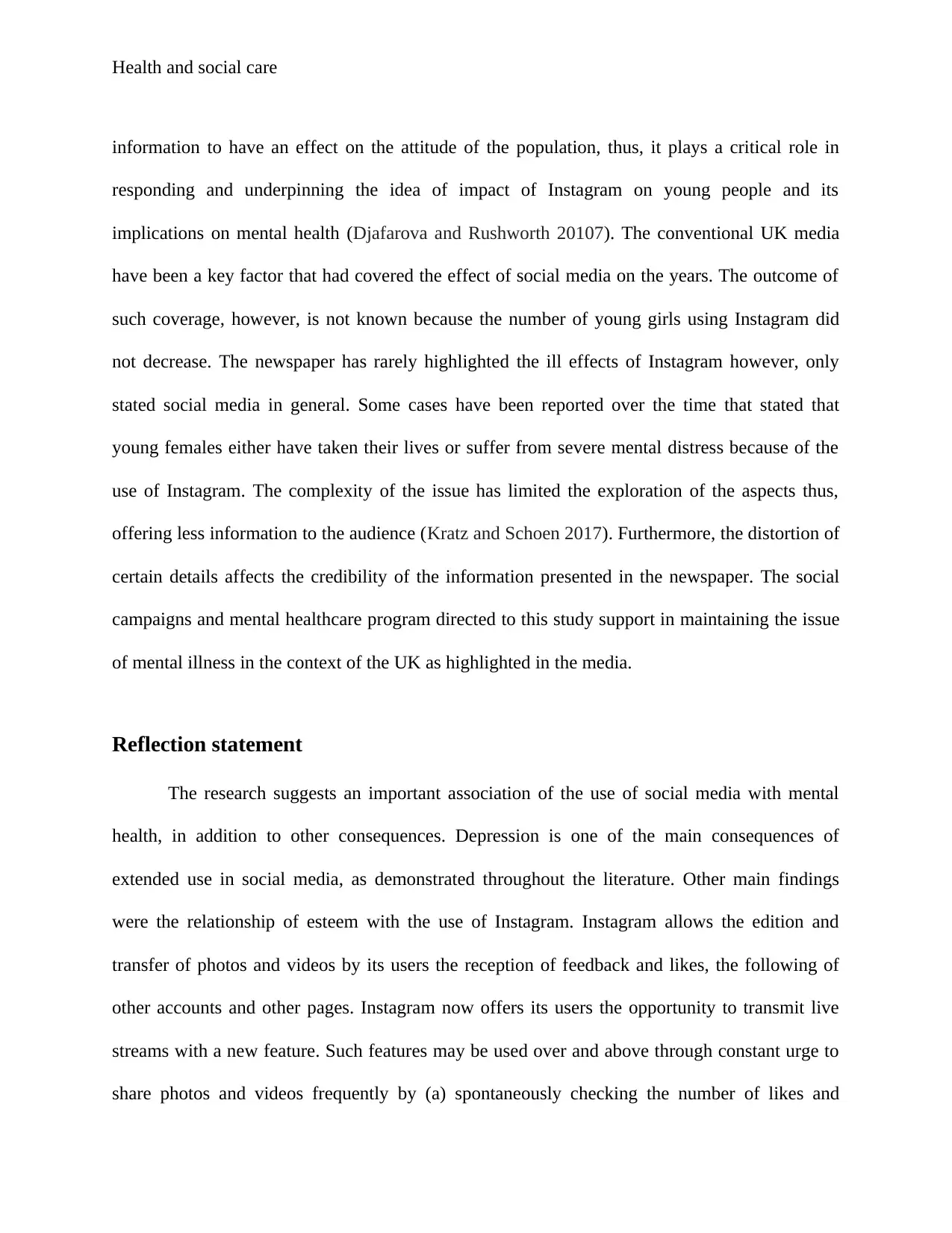
Health and social care
information to have an effect on the attitude of the population, thus, it plays a critical role in
responding and underpinning the idea of impact of Instagram on young people and its
implications on mental health (Djafarova and Rushworth 20107). The conventional UK media
have been a key factor that had covered the effect of social media on the years. The outcome of
such coverage, however, is not known because the number of young girls using Instagram did
not decrease. The newspaper has rarely highlighted the ill effects of Instagram however, only
stated social media in general. Some cases have been reported over the time that stated that
young females either have taken their lives or suffer from severe mental distress because of the
use of Instagram. The complexity of the issue has limited the exploration of the aspects thus,
offering less information to the audience (Kratz and Schoen 2017). Furthermore, the distortion of
certain details affects the credibility of the information presented in the newspaper. The social
campaigns and mental healthcare program directed to this study support in maintaining the issue
of mental illness in the context of the UK as highlighted in the media.
Reflection statement
The research suggests an important association of the use of social media with mental
health, in addition to other consequences. Depression is one of the main consequences of
extended use in social media, as demonstrated throughout the literature. Other main findings
were the relationship of esteem with the use of Instagram. Instagram allows the edition and
transfer of photos and videos by its users the reception of feedback and likes, the following of
other accounts and other pages. Instagram now offers its users the opportunity to transmit live
streams with a new feature. Such features may be used over and above through constant urge to
share photos and videos frequently by (a) spontaneously checking the number of likes and
information to have an effect on the attitude of the population, thus, it plays a critical role in
responding and underpinning the idea of impact of Instagram on young people and its
implications on mental health (Djafarova and Rushworth 20107). The conventional UK media
have been a key factor that had covered the effect of social media on the years. The outcome of
such coverage, however, is not known because the number of young girls using Instagram did
not decrease. The newspaper has rarely highlighted the ill effects of Instagram however, only
stated social media in general. Some cases have been reported over the time that stated that
young females either have taken their lives or suffer from severe mental distress because of the
use of Instagram. The complexity of the issue has limited the exploration of the aspects thus,
offering less information to the audience (Kratz and Schoen 2017). Furthermore, the distortion of
certain details affects the credibility of the information presented in the newspaper. The social
campaigns and mental healthcare program directed to this study support in maintaining the issue
of mental illness in the context of the UK as highlighted in the media.
Reflection statement
The research suggests an important association of the use of social media with mental
health, in addition to other consequences. Depression is one of the main consequences of
extended use in social media, as demonstrated throughout the literature. Other main findings
were the relationship of esteem with the use of Instagram. Instagram allows the edition and
transfer of photos and videos by its users the reception of feedback and likes, the following of
other accounts and other pages. Instagram now offers its users the opportunity to transmit live
streams with a new feature. Such features may be used over and above through constant urge to
share photos and videos frequently by (a) spontaneously checking the number of likes and
⊘ This is a preview!⊘
Do you want full access?
Subscribe today to unlock all pages.

Trusted by 1+ million students worldwide
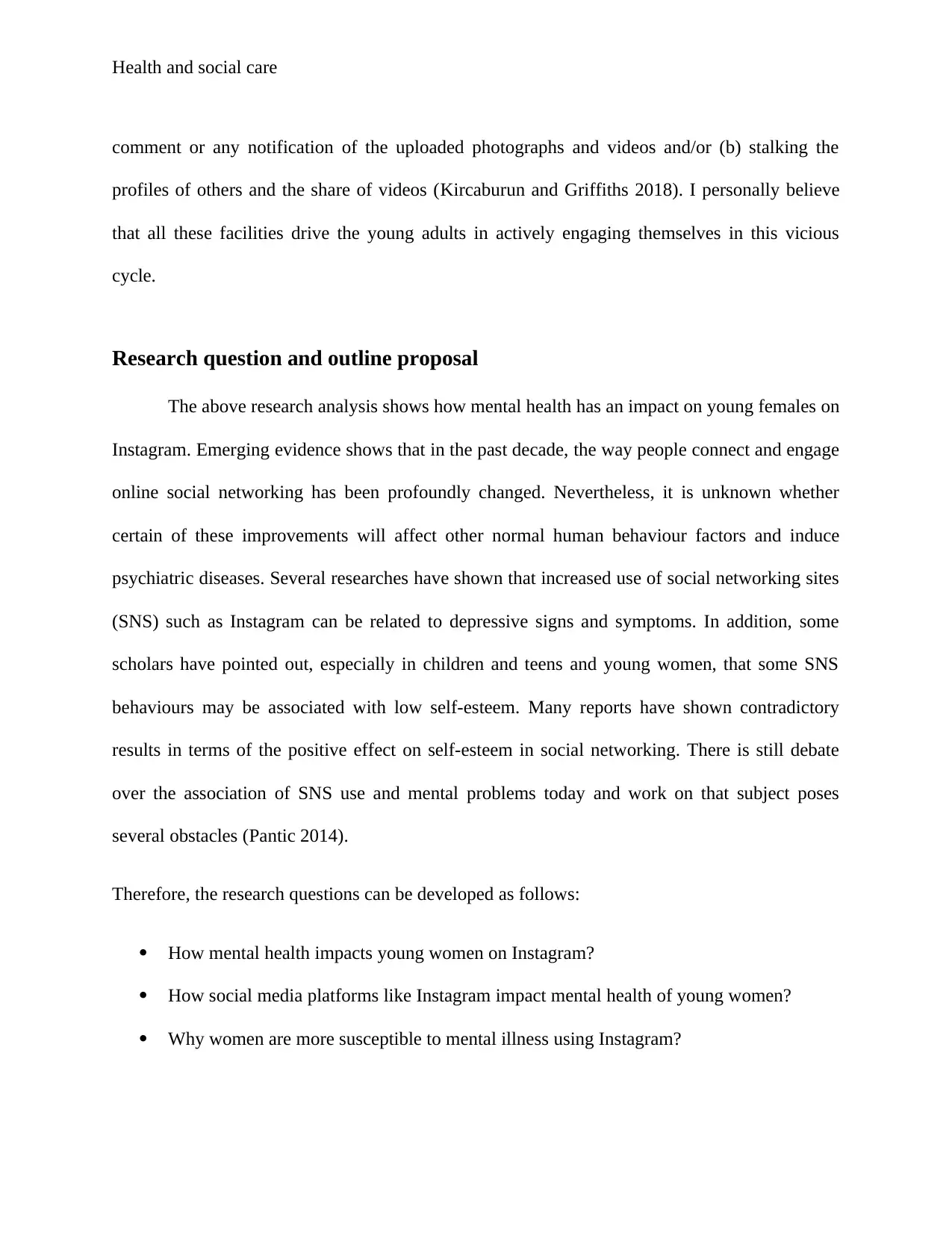
Health and social care
comment or any notification of the uploaded photographs and videos and/or (b) stalking the
profiles of others and the share of videos (Kircaburun and Griffiths 2018). I personally believe
that all these facilities drive the young adults in actively engaging themselves in this vicious
cycle.
Research question and outline proposal
The above research analysis shows how mental health has an impact on young females on
Instagram. Emerging evidence shows that in the past decade, the way people connect and engage
online social networking has been profoundly changed. Nevertheless, it is unknown whether
certain of these improvements will affect other normal human behaviour factors and induce
psychiatric diseases. Several researches have shown that increased use of social networking sites
(SNS) such as Instagram can be related to depressive signs and symptoms. In addition, some
scholars have pointed out, especially in children and teens and young women, that some SNS
behaviours may be associated with low self-esteem. Many reports have shown contradictory
results in terms of the positive effect on self-esteem in social networking. There is still debate
over the association of SNS use and mental problems today and work on that subject poses
several obstacles (Pantic 2014).
Therefore, the research questions can be developed as follows:
How mental health impacts young women on Instagram?
How social media platforms like Instagram impact mental health of young women?
Why women are more susceptible to mental illness using Instagram?
comment or any notification of the uploaded photographs and videos and/or (b) stalking the
profiles of others and the share of videos (Kircaburun and Griffiths 2018). I personally believe
that all these facilities drive the young adults in actively engaging themselves in this vicious
cycle.
Research question and outline proposal
The above research analysis shows how mental health has an impact on young females on
Instagram. Emerging evidence shows that in the past decade, the way people connect and engage
online social networking has been profoundly changed. Nevertheless, it is unknown whether
certain of these improvements will affect other normal human behaviour factors and induce
psychiatric diseases. Several researches have shown that increased use of social networking sites
(SNS) such as Instagram can be related to depressive signs and symptoms. In addition, some
scholars have pointed out, especially in children and teens and young women, that some SNS
behaviours may be associated with low self-esteem. Many reports have shown contradictory
results in terms of the positive effect on self-esteem in social networking. There is still debate
over the association of SNS use and mental problems today and work on that subject poses
several obstacles (Pantic 2014).
Therefore, the research questions can be developed as follows:
How mental health impacts young women on Instagram?
How social media platforms like Instagram impact mental health of young women?
Why women are more susceptible to mental illness using Instagram?
Paraphrase This Document
Need a fresh take? Get an instant paraphrase of this document with our AI Paraphraser
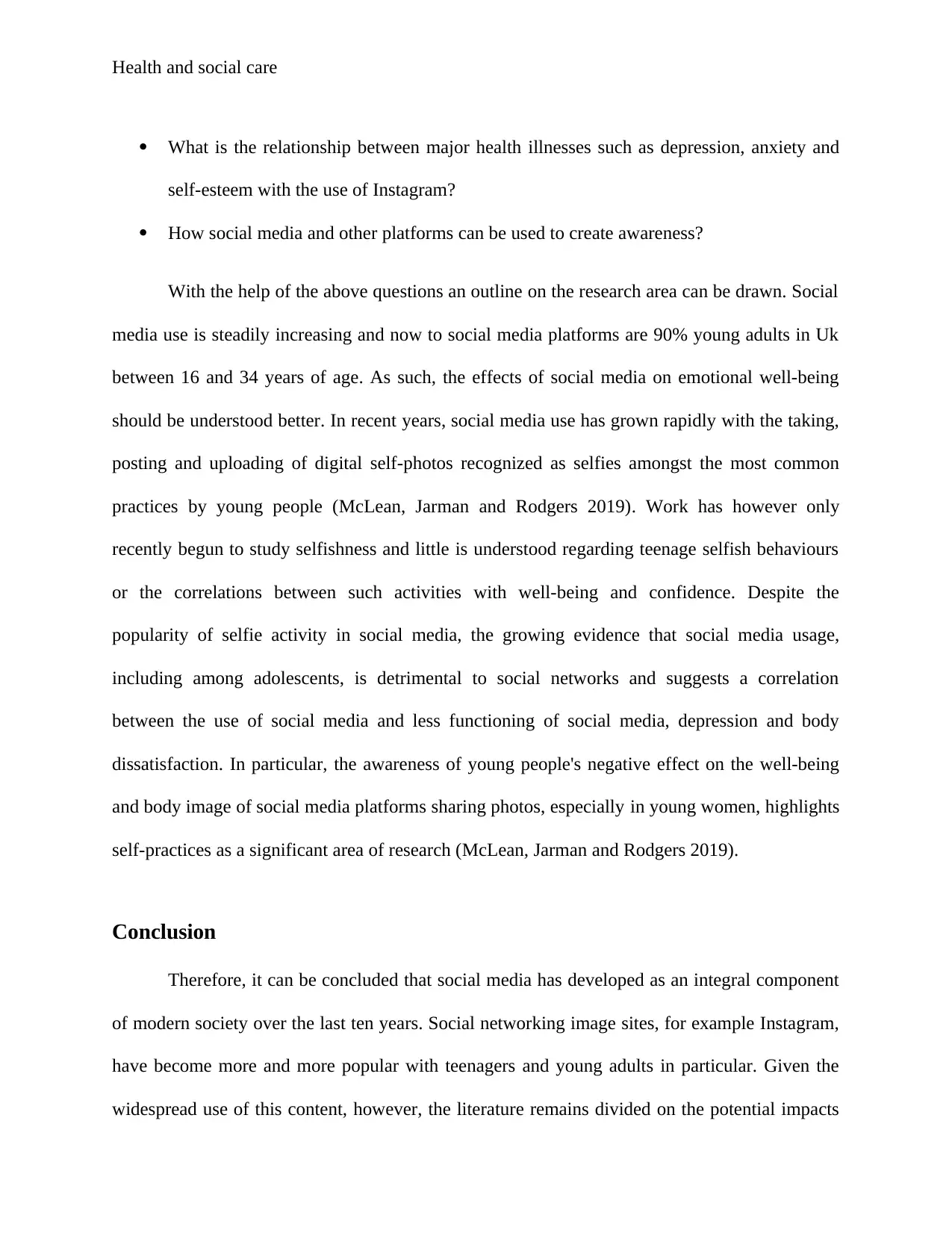
Health and social care
What is the relationship between major health illnesses such as depression, anxiety and
self-esteem with the use of Instagram?
How social media and other platforms can be used to create awareness?
With the help of the above questions an outline on the research area can be drawn. Social
media use is steadily increasing and now to social media platforms are 90% young adults in Uk
between 16 and 34 years of age. As such, the effects of social media on emotional well-being
should be understood better. In recent years, social media use has grown rapidly with the taking,
posting and uploading of digital self-photos recognized as selfies amongst the most common
practices by young people (McLean, Jarman and Rodgers 2019). Work has however only
recently begun to study selfishness and little is understood regarding teenage selfish behaviours
or the correlations between such activities with well-being and confidence. Despite the
popularity of selfie activity in social media, the growing evidence that social media usage,
including among adolescents, is detrimental to social networks and suggests a correlation
between the use of social media and less functioning of social media, depression and body
dissatisfaction. In particular, the awareness of young people's negative effect on the well-being
and body image of social media platforms sharing photos, especially in young women, highlights
self-practices as a significant area of research (McLean, Jarman and Rodgers 2019).
Conclusion
Therefore, it can be concluded that social media has developed as an integral component
of modern society over the last ten years. Social networking image sites, for example Instagram,
have become more and more popular with teenagers and young adults in particular. Given the
widespread use of this content, however, the literature remains divided on the potential impacts
What is the relationship between major health illnesses such as depression, anxiety and
self-esteem with the use of Instagram?
How social media and other platforms can be used to create awareness?
With the help of the above questions an outline on the research area can be drawn. Social
media use is steadily increasing and now to social media platforms are 90% young adults in Uk
between 16 and 34 years of age. As such, the effects of social media on emotional well-being
should be understood better. In recent years, social media use has grown rapidly with the taking,
posting and uploading of digital self-photos recognized as selfies amongst the most common
practices by young people (McLean, Jarman and Rodgers 2019). Work has however only
recently begun to study selfishness and little is understood regarding teenage selfish behaviours
or the correlations between such activities with well-being and confidence. Despite the
popularity of selfie activity in social media, the growing evidence that social media usage,
including among adolescents, is detrimental to social networks and suggests a correlation
between the use of social media and less functioning of social media, depression and body
dissatisfaction. In particular, the awareness of young people's negative effect on the well-being
and body image of social media platforms sharing photos, especially in young women, highlights
self-practices as a significant area of research (McLean, Jarman and Rodgers 2019).
Conclusion
Therefore, it can be concluded that social media has developed as an integral component
of modern society over the last ten years. Social networking image sites, for example Instagram,
have become more and more popular with teenagers and young adults in particular. Given the
widespread use of this content, however, the literature remains divided on the potential impacts
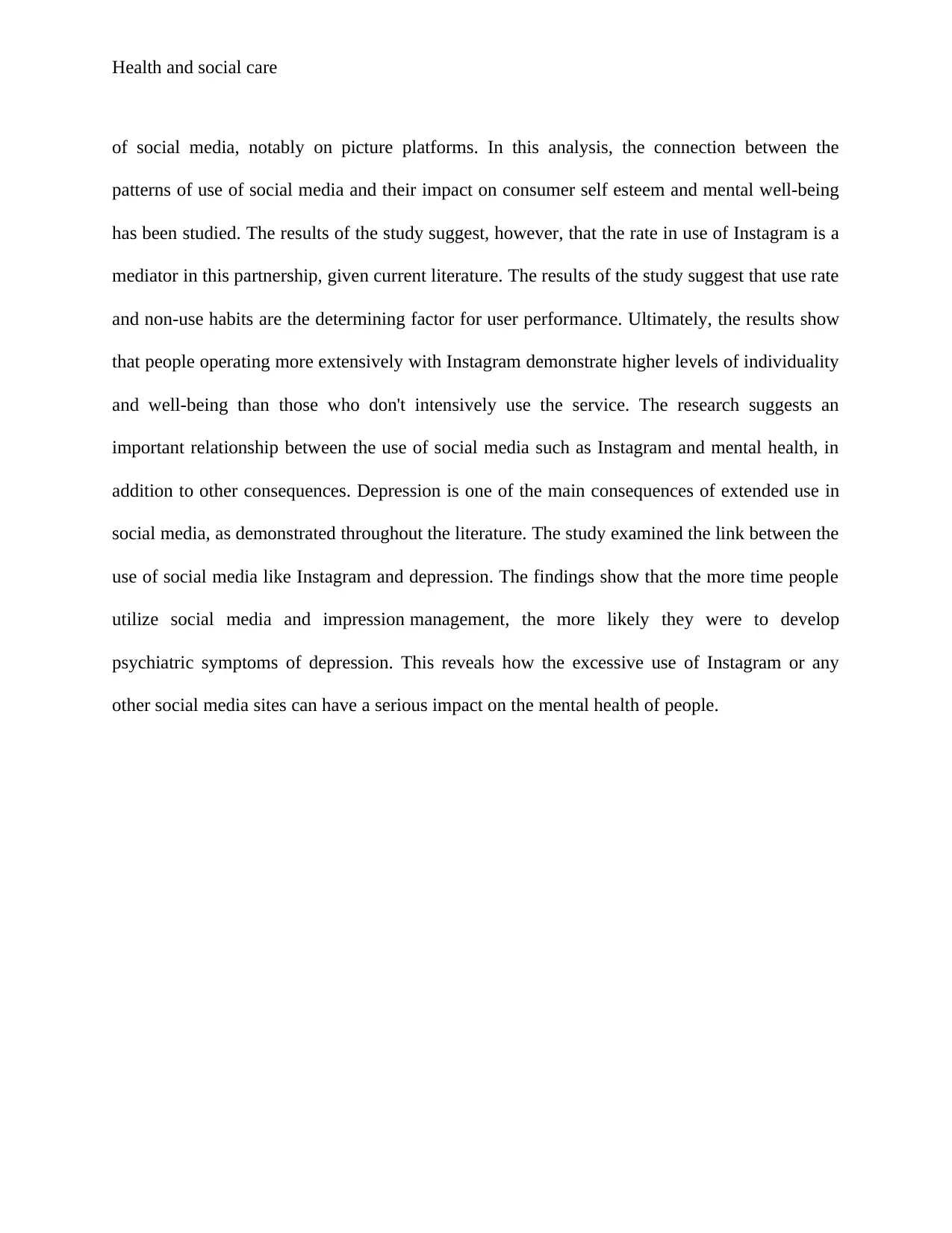
Health and social care
of social media, notably on picture platforms. In this analysis, the connection between the
patterns of use of social media and their impact on consumer self esteem and mental well-being
has been studied. The results of the study suggest, however, that the rate in use of Instagram is a
mediator in this partnership, given current literature. The results of the study suggest that use rate
and non-use habits are the determining factor for user performance. Ultimately, the results show
that people operating more extensively with Instagram demonstrate higher levels of individuality
and well-being than those who don't intensively use the service. The research suggests an
important relationship between the use of social media such as Instagram and mental health, in
addition to other consequences. Depression is one of the main consequences of extended use in
social media, as demonstrated throughout the literature. The study examined the link between the
use of social media like Instagram and depression. The findings show that the more time people
utilize social media and impression management, the more likely they were to develop
psychiatric symptoms of depression. This reveals how the excessive use of Instagram or any
other social media sites can have a serious impact on the mental health of people.
of social media, notably on picture platforms. In this analysis, the connection between the
patterns of use of social media and their impact on consumer self esteem and mental well-being
has been studied. The results of the study suggest, however, that the rate in use of Instagram is a
mediator in this partnership, given current literature. The results of the study suggest that use rate
and non-use habits are the determining factor for user performance. Ultimately, the results show
that people operating more extensively with Instagram demonstrate higher levels of individuality
and well-being than those who don't intensively use the service. The research suggests an
important relationship between the use of social media such as Instagram and mental health, in
addition to other consequences. Depression is one of the main consequences of extended use in
social media, as demonstrated throughout the literature. The study examined the link between the
use of social media like Instagram and depression. The findings show that the more time people
utilize social media and impression management, the more likely they were to develop
psychiatric symptoms of depression. This reveals how the excessive use of Instagram or any
other social media sites can have a serious impact on the mental health of people.
⊘ This is a preview!⊘
Do you want full access?
Subscribe today to unlock all pages.

Trusted by 1+ million students worldwide
1 out of 15
Related Documents
Your All-in-One AI-Powered Toolkit for Academic Success.
+13062052269
info@desklib.com
Available 24*7 on WhatsApp / Email
![[object Object]](/_next/static/media/star-bottom.7253800d.svg)
Unlock your academic potential
Copyright © 2020–2025 A2Z Services. All Rights Reserved. Developed and managed by ZUCOL.





